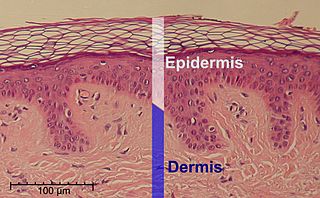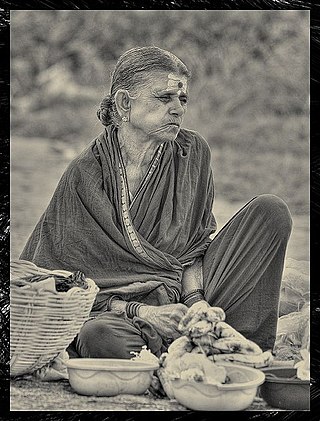
Skin is the layer of usually soft, flexible outer tissue covering the body of a vertebrate animal, with three main functions: protection, regulation, and sensation.

The integumentary system is the set of organs forming the outermost layer of an animal's body. It comprises the skin and its appendages, which act as a physical barrier between the external environment and the internal environment that it serves to protect and maintain the body of the animal. Mainly it is the body's outer skin.

A scar is an area of fibrous tissue that replaces normal skin after an injury. Scars result from the biological process of wound repair in the skin, as well as in other organs, and tissues of the body. Thus, scarring is a natural part of the healing process. With the exception of very minor lesions, every wound results in some degree of scarring. An exception to this are animals with complete regeneration, which regrow tissue without scar formation.

The epidermis is the outermost of the three layers that comprise the skin, the inner layers being the dermis and hypodermis. The epidermis layer provides a barrier to infection from environmental pathogens and regulates the amount of water released from the body into the atmosphere through transepidermal water loss.

The hair follicle is an organ found in mammalian skin. It resides in the dermal layer of the skin and is made up of 20 different cell types, each with distinct functions. The hair follicle regulates hair growth via a complex interaction between hormones, neuropeptides, and immune cells. This complex interaction induces the hair follicle to produce different types of hair as seen on different parts of the body. For example, terminal hairs grow on the scalp and lanugo hairs are seen covering the bodies of fetuses in the uterus and in some newborn babies. The process of hair growth occurs in distinct sequential stages: anagen is the active growth phase, catagen is the regression of the hair follicle phase, telogen is the resting stage, exogen is the active shedding of hair phase and kenogen is the phase between the empty hair follicle and the growth of new hair.

A skin condition, also known as cutaneous condition, is any medical condition that affects the integumentary system—the organ system that encloses the body and includes skin, nails, and related muscle and glands. The major function of this system is as a barrier against the external environment.

Nevus is a nonspecific medical term for a visible, circumscribed, chronic lesion of the skin or mucosa. The term originates from nævus, which is Latin for "birthmark"; however, a nevus can be either congenital or acquired. Common terms, including mole, birthmark, and beauty mark, are used to describe nevi, but these terms do not distinguish specific types of nevi from one another.

The subcutaneous tissue, also called the hypodermis, hypoderm, subcutis, superficial fascia, is the lowermost layer of the integumentary system in vertebrates. The types of cells found in the layer are fibroblasts, adipose cells, and macrophages. The subcutaneous tissue is derived from the mesoderm, but unlike the dermis, it is not derived from the mesoderm's dermatome region. It consists primarily of loose connective tissue, and contains larger blood vessels and nerves than those found in the dermis. It is a major site of fat storage in the body.

Loose connective tissue, also know as areolar tissue, is a cellular connective tissue with thin and relatively sparse collagen fibers. Its ground substance occupies more volume than the fibers do. It has a viscous to gel-like consistency and plays an important role in the diffusion of oxygen and nutrients from the capillaries that course through this connective tissue as well as in the diffusion of carbon dioxide and metabolic wastes back to the vessels. Moreover, loose connective tissue is primarily located beneath the epithelia that cover the body surfaces and line the internal surfaces of the body. It is also associated with the epithelium of glands and surrounds the smallest blood vessels. This tissue is thus the initial site where pathogenic agents, such as bacteria that have breached an epithelial surface, are challenged and destroyed by cells of the immune system.
Protection from mechanical injury, chemical hazards, and bacterial invasion is provided by the skin because the epidermis is relatively thick and covered with keratin. Secretions from sebaceous glands and sweat glands also benefit this protective barrier. In the event of an injury that damages the skin's protective barrier, the body triggers a response called wound healing. After hemostasis, inflammation white blood cells, including phagocytic macrophages arrive at the injury site. Once the invading microorganisms have been brought under control, the skin proceeds to heal itself. The ability of the skin to heal even after considerable damage has occurred is due to the presence of stem cells in the dermis and cells in the stratum basale of the epidermis, all of which can generate new tissue.
Snakeskin may either refer to the skin of a live snake, the shed skin of a snake after molting, or to a type of leather that is made from the hide of a dead snake. Snakeskin and scales can have varying patterns and color formations, providing protection via camouflage from predators. The colors and iridescence in these scales are largely determined by the types and amount of chromatophores located in the dermis of the snake skin. The snake's skin and scales are also an important feature to their locomotion, providing protection and minimizing friction when gliding over surfaces.

Stroma is the part of a tissue or organ with a structural or connective role. It is made up of all the parts without specific functions of the organ - for example, connective tissue, blood vessels, ducts, etc. The other part, the parenchyma, consists of the cells that perform the function of the tissue or organ.

The human skin is the outer covering of the body and is the largest organ of the integumentary system. The skin has up to seven layers of ectodermal tissue guarding muscles, bones, ligaments and internal organs. Human skin is similar to most of the other mammals' skin, and it is very similar to pig skin. Though nearly all human skin is covered with hair follicles, it can appear hairless. There are two general types of skin, hairy and glabrous skin (hairless). The adjective cutaneous literally means "of the skin".

Photoaging or photoageing is a term used for the characteristic changes to skin induced by chronic UVA and UVB exposure. Tretinoin is the best studied retinoid in the treatment of photoaging.
Elaunin is a component of elastic fibers formed from a deposition of elastin between oxytalan fibers. It is found in the periodontal ligament and in the connective tissue of the dermis, particularly in association with sweat glands.
Role of skin in locomotion describes how the integumentary system is involved in locomotion. Typically the integumentary system can be thought of as skin, however the integumentary system also includes the segmented exoskeleton in arthropods and feathers of birds. The primary role of the integumentary system is to provide protection for the body. However, the structure of the skin has evolved to aid animals in their different modes of locomotion. Soft bodied animals such as starfish rely on the arrangement of the fibers in their tube feet for movement. Eels, snakes, and fish use their skin like an external tendon to generate the propulsive forces need for undulatory locomotion. Vertebrates that fly, glide, and parachute also have a characteristic fiber arrangements of their flight membranes that allows for the skin to maintain its structural integrity during the stress and strain experienced during flight.
Dermal fibroblasts are cells within the dermis layer of skin which are responsible for generating connective tissue and allowing the skin to recover from injury. Using organelles, dermal fibroblasts generate and maintain the connective tissue which unites separate cell layers. Furthermore, these dermal fibroblasts produce the protein molecules including laminin and fibronectin which comprise the extracellular matrix. By creating the extracellular matrix between the dermis and epidermis, fibroblasts allow the epithelial cells of the epidermis to affix the matrix, thereby allowing the epidermal cells to effectively join together to form the top layer of the skin.
The dermoepidermal junction or dermal-epidermal junction (DEJ) is the area of tissue that joins the epidermal and the dermal layers of the skin. The basal cells in the stratum basale of the epidermis connect to the basement membrane by the anchoring filaments of hemidesmosomes; the cells of the papillary layer of the dermis are attached to the basement membrane by anchoring fibrils, which consist of type VII collagen.
Hydradermabrasion is a dermatological procedure which combines simultaneous dermal infusion of medicinal products and crystal-free exfoliation. Hydradermabrasion's mechanism of actions includes: (a) mechanical stimulation activates the basal layer, and (b) thickening and smoothing the epidermis. Fibroblast activity results in extracellular matrix deposition and dermal thickening. Antioxidants introduced through the procedure hydrate and decrease inflammation in the skin, reversing photo damage, while protecting lipid membranes, collagen fibers, and enzyme systems.

Collagen is a protein that is an important part of connective tissues in the body. It is a rigid, non-soluble and fibrous protein that adds up to one third of the proteins found in the human body. Collagen is mostly made up of molecules that are packed together to form long and thin fibrils that support each other and ensure the skin is strong and elastic. There are various types of collagen which have individual roles and structures. Most collagen belongs to types 1, 2 and 3. Collagen consists mainly of amino acids and can be mostly found in tendons, muscles, bones, skin, ligaments and other fibrous tissues. It helps keep the skin strong and supple, and sustains the renewal of skin cells and replacement of damaged and dead body cells. The collagen tissues support the formation of bones, tendons, and cartilage that form depending on the level of mineralization. However, an individual can lose collagen components in the body due to exposure to ultraviolet light, tobacco, excessive intake of sugar, and aging. This loss of collagen can cause the skin to lose elasticity, reduction of the thickness of the epidermis, increase in the formation of wrinkles and sagging, and also make the skin vulnerable and easily damaged.






















